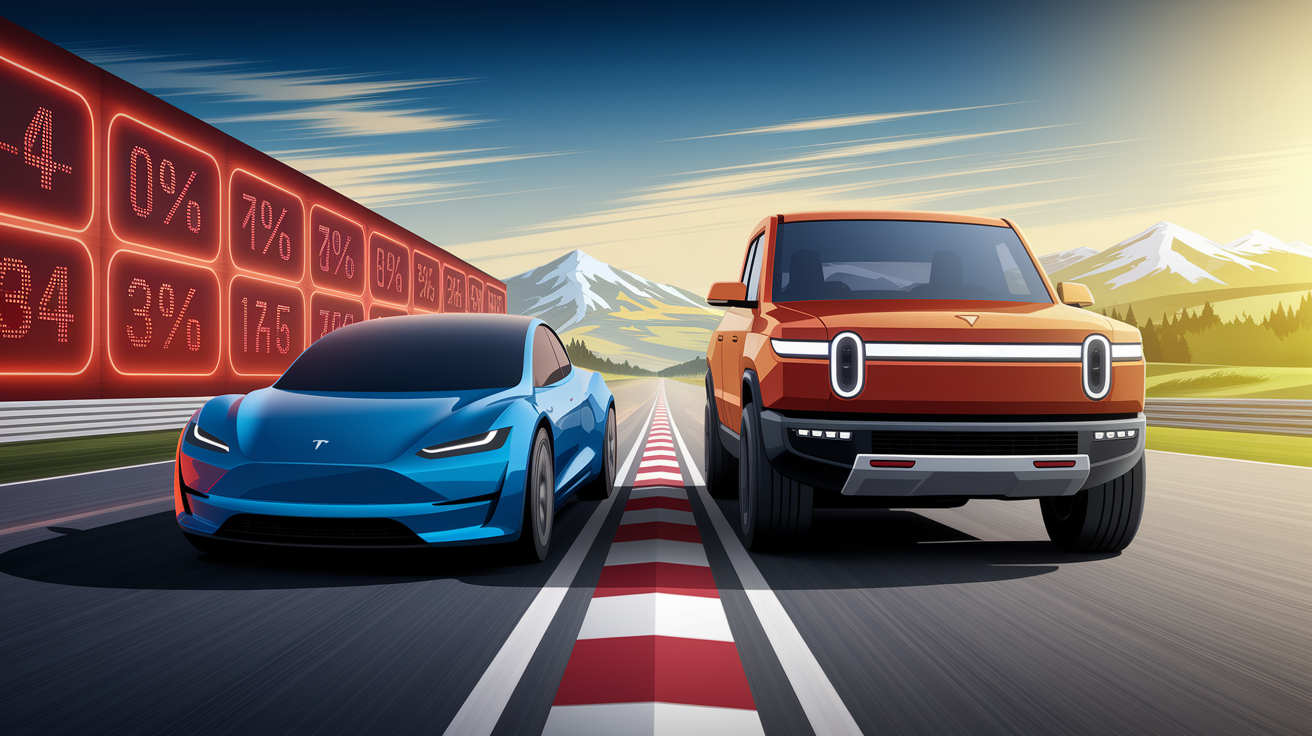The electric vehicle market is a battlefield, with Tesla and Rivian at the forefront of this electrifying race. Tesla, an experienced veteran, is known for its cutting-edge technology and market dominance. Rivian, a newcomer making waves, focuses on electric trucks and SUVs. This article delves into the dynamics of market share and the technological and financial challenges these companies face, providing crucial insights for investors and private stakeholders.
Navigating Market Share: Strategies and Challenges for Tesla and Rivian

In the competitive realm of electric vehicles (EVs), Tesla and Rivian emerge as intriguing players, each charting unique paths toward market dominance. Tesla, with its prestigious past, holds an impressive share, maintaining around 50% of sales volume in the EV sector. This dominance is reflected not only in its wide range of modern electric vehicles but also in its technological capabilities, particularly in autonomous driving and battery innovation. Rivian, while relatively young, marks its presence through specialized offerings in high-end electric SUVs and the upcoming R2 platform aimed at the sub-$50,000 market segment.
Tesla’s market strategy is deeply rooted in innovation and expansion. With a focus on continuously developing its product range, such as the much-awaited Cybertruck, and enhancing its renowned Autopilot system, Tesla strives to maintain its market hegemony. A critical advantage for Tesla is its comprehensive charging infrastructure, which represents a significant convenience factor for consumers, further strengthening its market position. Meanwhile, Rivian leverages strategic alliances, particularly with Amazon for electric delivery vans, which not only bolster its revenue streams but also highlight its commitment to cost efficiency and scalability.
However, the road is fraught with challenges for both manufacturers. Tesla faces external pressures from geopolitical tensions and nuanced brand perceptions in certain international markets, alongside strong competition in the ever-evolving EV landscape in China. Conversely, Rivian must navigate complex obstacles related to scaling its production capabilities and managing uncertainties regarding tariffs that threaten to undermine its operational efficiency.
From a financial standpoint, the disparity between the two is stark. Tesla boasts a market capitalization exceeding $800 billion, providing a fiscal cushion to fuel its vast R&D initiatives. On the other hand, Rivian, with a market capitalization of $12 billion, is still on its journey toward profitability, reflected in its losses per share. While Tesla’s stock shows considerable volatility, it still presents good long-term returns. Rivian’s shares, while less volatile, have experienced significant fluctuations since its public debut, highlighting the intrinsic risks involved.
Ultimately, as Tesla and Rivian continue to innovate and adapt, their market share dynamics illustrate a broader narrative of competition and growth within the EV industry. Each company, with its distinct strategies and hurdles, contributes to the vibrant tapestry of this transformative sector, underscoring the relentless pursuit of innovation that defines today’s automotive landscape.
Navigating Technological and Financial Hurdles: Tesla and Rivian’s Strategic Path

In the competitive realm of electric vehicles, Tesla and Rivian face distinct technological and financial challenges that shape their strategies and influence their market positions. As these companies strive for innovation and expansion, overcoming these hurdles is crucial for sustaining growth and maintaining competitiveness.
Tesla, the pioneer of the EV market, is often praised for its cutting-edge technology, particularly in autonomous driving and battery innovation. However, like any industry leader, maintaining this innovation presents its own set of challenges. Change management is a significant hurdle as the company expands its technological capabilities. Developing a culture of continuous learning and innovation is essential to ensure that new technologies are implemented effectively. Additionally, protecting intangible assets such as software and intellectual property is critical, as these components are instrumental in sustaining Tesla’s competitive advantage. Furthermore, Tesla faces a complex web of regulatory and legal challenges associated with expanding its technological offerings.
On the other hand, Rivian strategically positions itself within the niche of electric trucks and SUVs. While its technological aspirations are high, Rivian encounters challenges in production and scalability that test its ability to deliver on its promises. A significant part of Rivian’s technological strategy involves its proprietary Autonomous Platform, which, while promising, requires substantial investment and development. Data management and analytics are also crucial as Rivian seeks to refine its offerings and gain insights into consumer preferences. The company’s focus on building nimble, API-driven architectures is vital for enhancing the interoperability of its systems, aiding in the seamless management of new technologies.
Financially, Tesla, with its substantial market valuation, faces the challenge of maintaining investor confidence amid fluctuating market conditions. The challenge lies not only in profitability but also in justifying high valuations through continued growth and innovation. Rivian, in contrast, is in the phase of securing a path to profitability. Ensuring effective cash flow management and accessing funding solutions is crucial for Rivian as it works to increase production capacity and deliver vehicles to consumers.
Both companies are also influenced by external pressures such as cybersecurity threats and the need for robust data protection measures. As they leverage data-driven insights to enhance their business models, ensuring the security of customer data becomes non-negotiable. For Rivian and Tesla, the strategic application of AI-driven innovations not only propels product development but also helps improve operational efficiency, from manufacturing processes to optimizing financial forecasting.
In conclusion, Tesla and Rivian must skillfully navigate these technological and financial challenges through strategic planning and innovation. Success in these areas promises not only to reinforce their market standing but also to push the boundaries of what is possible in the evolving narrative of electric vehicles.